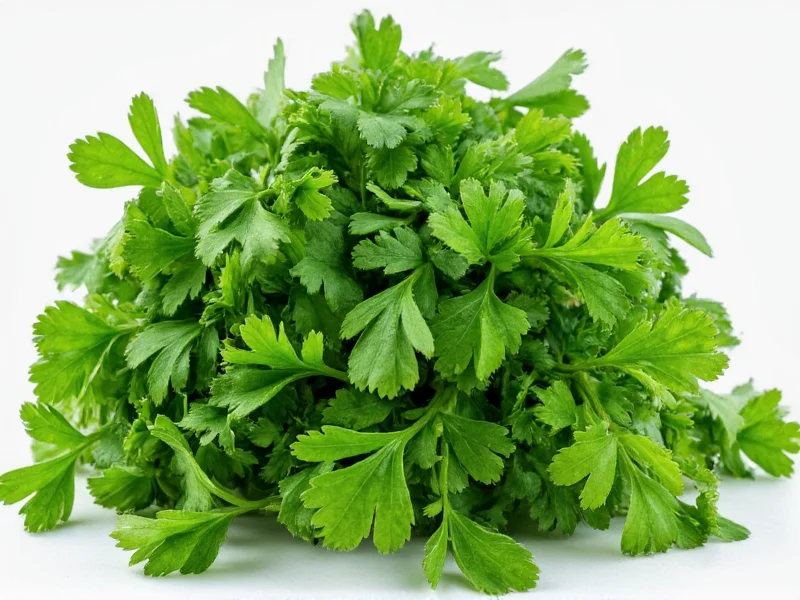When standing in the grocery store staring at two nearly identical bunches of leafy greens, it's easy to confuse cilantro and Italian parsley. This common mix-up happens because both herbs feature flat leaves and similar vibrant green coloring. However, understanding the critical differences between these herbs can transform your cooking experience and prevent recipe disasters.
Botanical Classification and Origins
Cilantro, also known as coriander leaf or Chinese parsley, comes from the Coriandrum sativum plant. This herb has been used for thousands of years across Asian, Latin American, and Middle Eastern cuisines. Every part of the plant is utilized—seeds become coriander spice, roots feature in Thai cooking, and the leaves give dishes their distinctive cilantro flavor.
Italian parsley, technically called flat-leaf parsley or Petroselinum crispum neapolitanum, belongs to the same family as celery and carrots. Originating in the Mediterranean region, this variety differs from the more common curly parsley with its flatter, broader leaves and more robust flavor profile compared to its curly counterpart.
Visual Comparison: Telling Them Apart
While both herbs share a general appearance, careful observation reveals key differences. The most reliable method for distinguishing cilantro from Italian parsley involves examining the leaf shape and stem structure.
| Feature | Cilantro | Italian Parsley |
|---|---|---|
| Leaf Shape | Rounded, almost circular with smooth edges | Pointed, serrated edges resembling flat triangles |
| Leaf Texture | Softer, more delicate | Firmer, slightly tougher |
| Stem Color | Pale green to white | Deeper green |
| Aroma | Strong citrus scent with soapy notes | Mild, grassy, fresh scent |
Flavor Profiles: Why the Confusion Causes Culinary Disasters
The most significant difference between cilantro and Italian parsley lies in their flavor chemistry. Cilantro contains aldehydes that create its signature citrusy taste, which some people perceive as soapy due to genetic factors. Approximately 21% of the population has this cilantro soap perception trait.
Italian parsley delivers a clean, mild bitterness with subtle grassy notes—completely lacking the polarizing soapy quality that defines cilantro for certain individuals. This flavor difference explains why substituting one for the other can dramatically alter a dish's intended taste profile.
Culinary Applications: When to Use Each Herb
Chefs carefully select between these herbs based on the desired flavor outcome. Understanding the traditional uses of each helps prevent recipe mishaps when you're exploring difference between cilantro and Italian parsley in cooking.
Cilantro's Signature Roles
- Essential in Mexican cuisine (salsas, guacamole, ceviche)
- Key component in Southeast Asian dishes (curries, pho, spring rolls)
- Perfect for fresh applications where its bold flavor can shine
- Loses flavor quickly when cooked, best added at the end
Italian Parsley's Culinary Strengths
- Foundation herb in French mirepoix and Italian soffritto
- Classic finishing touch for Mediterranean dishes
- Holds up better to cooking than cilantro
- Preferred in tabbouleh, gremolata, and chimichurri
Substitution Guidance: Can You Swap Them?
When wondering how to tell cilantro from Italian parsley at the store, remember they're not interchangeable in most recipes. However, understanding when substitution might work can save a cooking emergency.
Replacing Italian parsley with cilantro works only in specific circumstances—typically when a recipe calls for minimal parsley and you want to introduce cilantro's distinctive flavor. The reverse substitution rarely succeeds because cilantro's strong taste overwhelms dishes designed for parsley's subtlety.
For those who perceive cilantro as soap, flat-leaf parsley makes an excellent substitute in recipes where cilantro's presence would be problematic, though the dish will lack authentic flavor.
Storage Tips for Maximum Freshness
Both herbs require similar storage methods but have different shelf lives. Treat them like cut flowers: trim stems, place in water, and cover loosely with a plastic bag in the refrigerator.
Cilantro typically lasts 5-7 days before wilting, while Italian parsley often maintains freshness for 10-14 days. For longer storage, chop and freeze both herbs in olive oil cubes—though cilantro's flavor degrades more significantly when frozen compared to parsley.
Common Confusion Points Explained
The persistent mix-up between these herbs stems from several factors. Many grocery stores display them side by side with minimal labeling. Some regions use "Chinese parsley" as a cilantro alternative name, creating further confusion with actual parsley varieties.
Additionally, the term "flat-leaf parsley" encompasses both Italian parsley and other flat-leaf varieties, while "coriander" refers to both the plant (including cilantro leaves) and its seeds depending on regional usage. This terminology overlap contributes to the ongoing confusion about whether cilantro and Italian parsley are the same.
Final Verdict: Making the Right Choice
When selecting herbs for your recipe, consider the dish's cultural origins. Authentic Mexican or Thai recipes almost always require cilantro, while Italian or French dishes typically call for Italian parsley. When in doubt, smell the herb—cilantro's distinctive citrus-soap aroma is unmistakable once you know what to look for.











 浙公网安备
33010002000092号
浙公网安备
33010002000092号 浙B2-20120091-4
浙B2-20120091-4